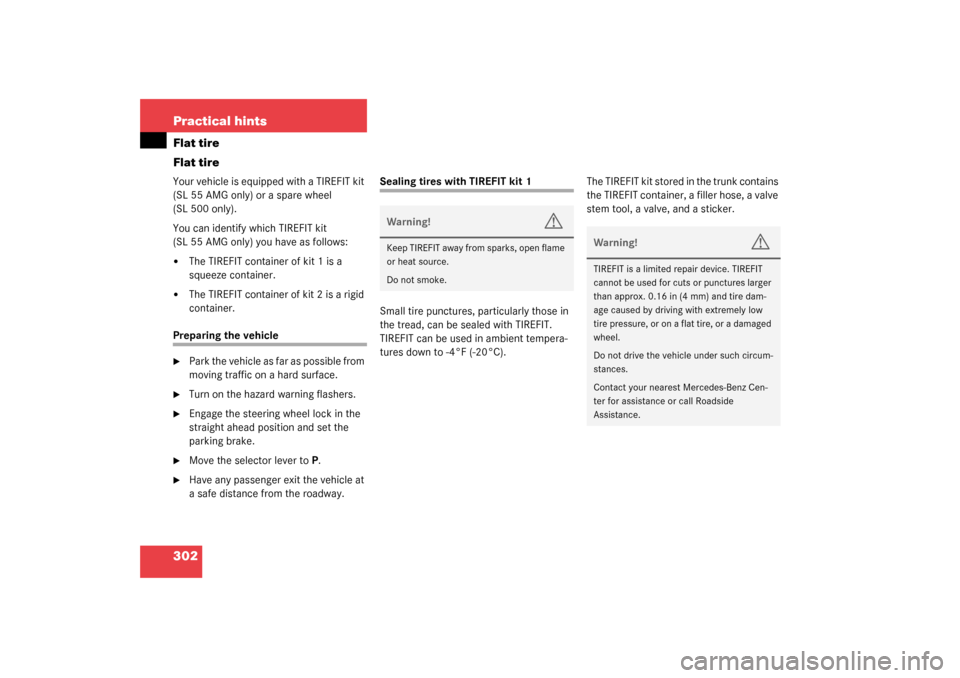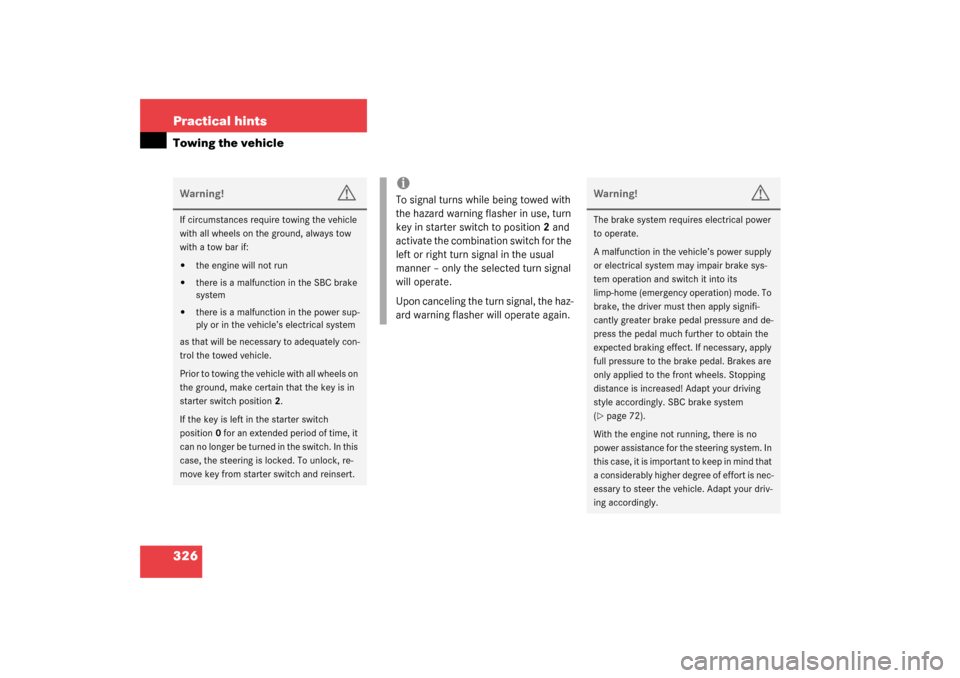Page 261 of 376
261 Practical hints
What to do if …
Left display
Right display
Possible cause
Possible solution
ESP
Defective!
Visit workshop!
The ESP is deactivated because of
a malfunction or an interrupted
power supply. The SBC brake sys-
tem is still functioning normally.
The ABS may still be operational.
�
With the vehicle stationary, turn the steering
wheel completely to the left and then to the
right to synchronize the ESP.
If the ESP message does not go out:
�
Continue driving with added caution.
�
Visit an authorized
Mercedes-Benz Center as soon as possible.
Failure to follow these instructions increases the
risk of accident.
Display defective
Visit workshop!
ESP or the ESP display is malfunc-
tioning.
�
Continue driving with added caution.
�
Visit an authorized
Mercedes-Benz Center as soon as possible.
Failure to follow these instructions increases the
risk of accident.
Page 271 of 376
271 Practical hints
What to do if …
Left display
Right display
Possible cause
Possible solution
F
KEYLESS GO
Check system
The KEYLESS-GO* system is mal-
functioning.
�
Visit an authorized Mercedes-Benz Center as
soon as possible.
Key
Do not forget
This display appears (for a maximum
of 60 seconds) if the driver’s door is
opened with the engine shut off and
no key in the starter switch.
Message is only a reminder.
�
Insert key in the starter switch.
�
Take the SmartKey with KEYLESS-GO* with
you when leaving the vehicle.
_
Entry position
Do not drive!
Seat, mirrors and steering wheel
have not yet moved into their preset
driving positions.
�
Wait until the seat, mirrors and steering
wheel have moved to their driving positions.
The message disappears.
Except Canada:;Canada only:!
Release
parking brake!
You are driving with the parking
brake set.
�
Release the parking brake (
�page 41).
Page 281 of 376
281 Practical hints
What to do if …
Left display
Right display
Possible cause
Possible solution
H
Tire pressure
Caution
tire defect!
One or more tires is rapidly deflat-
ing.
�
Carefully bring the vehicle to a halt, avoiding
abrupt steering and braking maneuvers.
�
Change the wheel (
�page 312).
Tire pressure
ChecK tires!
The tire pressure in one or more
tires is already below the minimum
value.
�
Carefully bring the vehicle to a halt, avoiding
abrupt steering and braking maneuvers.
�
Change the wheel (
�page 312).
The tire pressure in one or more
tires is low.
�
Check and correct tire pressure as required
(�page 236).
Warning!
G
Do not drive with a flat tire. A flat tire affects
the ability to steer or brake the vehicle. You
may lose control of the vehicle.
Continued driving with a flat tire will cause
excessive heat build-up and possibly a fire.
Page 283 of 376
283 Practical hints
What to do if …
Left display
Right display
Possible cause
Possible solution
H
Tire press. monit.
Visit workshop!
The tire inflation pressure monitor is
malfunctioning.
A wheel without proper sensor was
installed.
�
Have the tire inflation pressure monitor
checked by an authorized Mercedes-Benz
Center.
�
Change the wheel.
Tire pressure, RL
Caution
tire defect!
The left rear tire is rapidly deflating.
�
Carefully bring the vehicle to a halt, avoiding
abrupt steering and braking maneuvers.
�
Change the wheel (
�page 312).
Tire pressure, RL
Check tires!
The left rear tire pressure is low.
�
Carefully bring the vehicle to a halt.
�
Check the tire pressure.
�
Change the wheel (
�page 312).
Warning!
G
Do not drive with a flat tire. A flat tire affects
the ability to steer or brake the vehicle. You
may lose control of the vehicle.
Continued driving with a flat tire will cause
excessive heat build-up and possibly a fire.
Page 284 of 376
284 Practical hintsWhat to do if …Left display
Right display
Possible cause
Possible solution
H
Tire pressure, RR
Caution
tire defect!
The right rear tire is rapidly deflat-
ing.
�
Carefully bring the vehicle to a halt, avoiding
abrupt steering and braking maneuvers.
�
Change the wheel (
�page 312).
Tire pressure, RR
Check tires!
The right rear tire pressure is low.
�
Carefully bring the vehicle to a halt.
�
Check the tire pressure.
�
Change the wheel (
�page 312).
Tire pressure, FL
Caution
tire defect!
The left front tire is rapidly deflat-
ing.
�
Carefully bring the vehicle to a halt, avoiding
abrupt steering and braking maneuvers.
�
Change the wheel (
�page 312).
Warning!
G
Do not drive with a flat tire. A flat tire affects
the ability to steer or brake the vehicle. You
may lose control of the vehicle. Continued
driving with a flat tire will cause excessive
heat build-up and possibly a fire.
Page 285 of 376
285 Practical hints
What to do if …
Left display
Right display
Possible cause
Possible solution
H
Tire pressure, FL
Check tires!
The left front tire pressure is low.
�
Carefully bring the vehicle to a halt.
�
Check the tire pressure.
�
Change the wheel (
�page 312).
Tire pressure, FR
Caution
tire defect!
The right front tire is rapidly deflat-
ing.
�
Carefully bring the vehicle to a halt, avoiding
abrubt steering and braking maneuvers.
�
Change the wheel (
�page 312).
Tire pressure, FR
Check tires!
The right front tire pressure is low.
�
Carefully bring the vehicle to a halt.
�
Change the wheel (
�page 312).
Warning!
G
Do not drive with a flat tire. A flat tire affects
the ability to steer or brake the vehicle. You
may lose control of the vehicle. Continued
driving with a flat tire will cause excessive
heat build-up and possibly a fire.
Page 302 of 376

302 Practical hintsFlat tire
Flat tireYour vehicle is equipped with a TIREFIT kit
(SL 55 AMG only) or a spare wheel
(SL 500 only).
You can identify which TIREFIT kit
(SL 55 AMG only) you have as follows:�
The TIREFIT container of kit 1 is a
squeeze container.
�
The TIREFIT container of kit 2 is a rigid
container.
Preparing the vehicle�
Park the vehicle as far as possible from
moving traffic on a hard surface.
�
Turn on the hazard warning flashers.
�
Engage the steering wheel lock in the
straight ahead position and set the
parking brake.
�
Move the selector lever to P.
�
Have any passenger exit the vehicle at
a safe distance from the roadway.
Sealing tires with TIREFIT kit 1
Small tire punctures, particularly those in
the tread, can be sealed with TIREFIT.
TIREFIT can be used in ambient tempera-
tures down to -4°F (-20°C).The TIREFIT kit stored in the trunk contains
the TIREFIT container, a filler hose, a valve
stem tool, a valve, and a sticker.Warning!
G
Keep TIREFIT away from sparks, open flame
or heat source.
Do not smoke.
Warning!
G
TIREFIT is a limited repair device. TIREFIT
cannot be used for cuts or punctures larger
than approx. 0.16 in (4 mm) and tire dam-
age caused by driving with extremely low
tire pressure, or on a flat tire, or a damaged
wheel.
Do not drive the vehicle under such circum-
stances.
Contact your nearest Mercedes-Benz Cen-
ter for assistance or call Roadside
Assistance.
Page 326 of 376

326 Practical hintsTowing the vehicleWarning!
G
If circumstances require towing the vehicle
with all wheels on the ground, always tow
with a tow bar if:�
the engine will not run
�
there is a malfunction in the SBC brake
system
�
there is a malfunction in the power sup-
ply or in the vehicle’s electrical system
as that will be necessary to adequately con-
trol the towed vehicle.
Prior to towing the vehicle with all wheels on
the ground, make certain that the key is in
starter switch position2.
If the key is left in the starter switch
position0 for an extended period of time, it
can no longer be turned in the switch. In this
case, the steering is locked. To unlock, re-
move key from starter switch and reinsert.
iTo signal turns while being towed with
the hazard warning flasher in use, turn
key in starter switch to position2 and
activate the combination switch for the
left or right turn signal in the usual
manner – only the selected turn signal
will operate.
Upon canceling the turn signal, the haz-
ard warning flasher will operate again.
Warning!
G
The brake system requires electrical power
to operate.
A malfunction in the vehicle’s power supply
or electrical system may impair brake sys-
tem operation and switch it into its
limp-home (emergency operation) mode. To
brake, the driver must then apply signifi-
cantly greater brake pedal pressure and de-
press the pedal much further to obtain the
expected braking effect. If necessary, apply
full pressure to the brake pedal. Brakes are
only applied to the front wheels. Stopping
distance is increased! Adapt your driving
style accordingly. SBC brake system
(�page 72).
With the engine not running, there is no
power assistance for the steering system. In
this case, it is important to keep in mind that
a considerably higher degree of effort is nec-
essary to steer the vehicle. Adapt your driv-
ing accordingly.